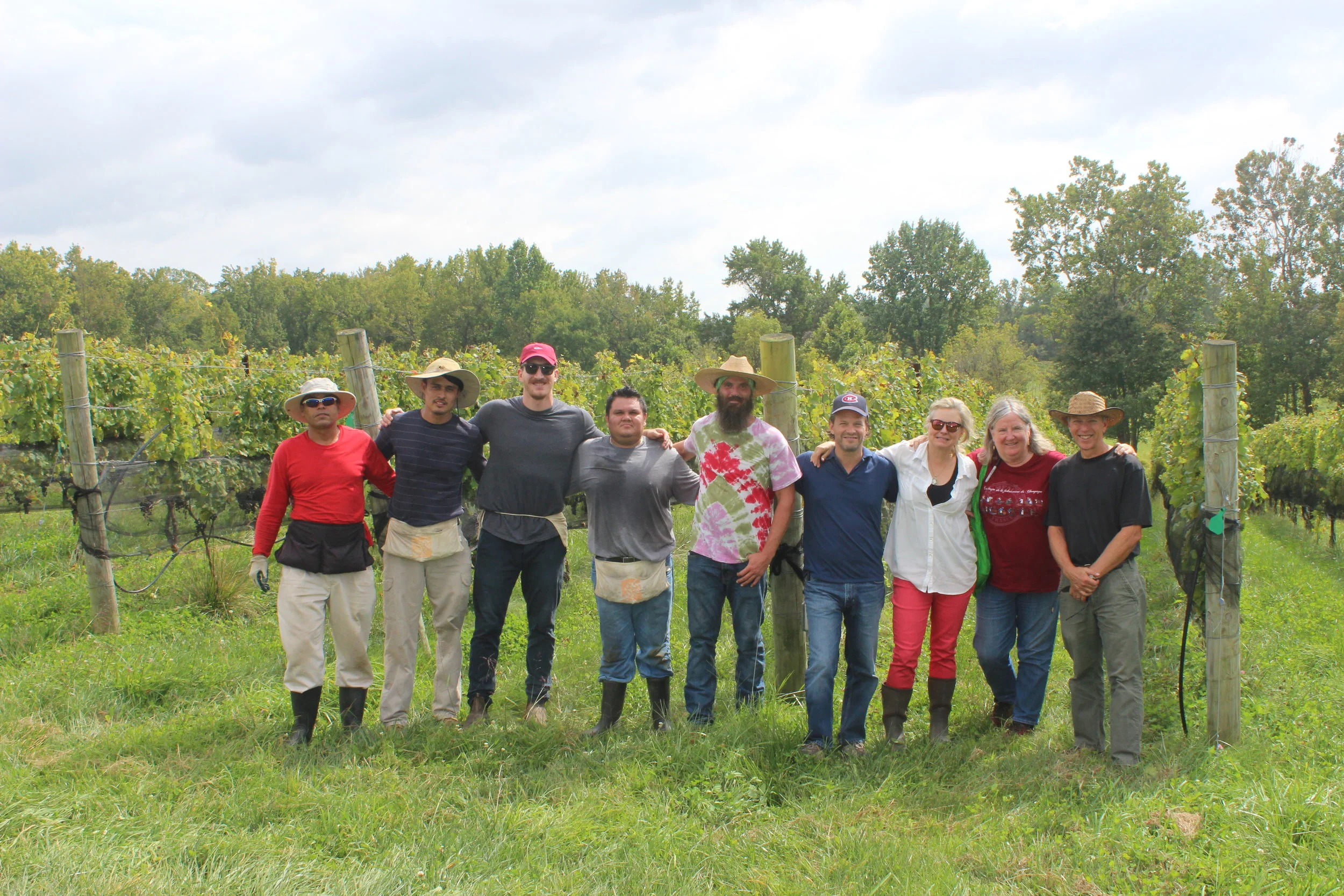In what has become a metaphor for the 2017 vintage, a black widow found her way onto the sorting table in the last hours of harvest. We’ve always known that there are lots of black widows in the vineyard, but mostly they keep to themselves, quietly helping rid the vines of unwanted insects. How she got to the table is anyone’s guess. It seems unlikely that she was on a cluster when it was snipped into an unsuspecting hand, so perhaps she crawled into a picking basket that inadvertently landed on her web. In either case, we popped both the spider and her grape into the sorting bin, and off she went to the compost pile. No harm done to either party.
For me, it was the last of a long string of “near-miss” reminders that nature is very present, very powerful, and very much in charge. It started with the false spring in late February, with temperatures reaching 79 degrees on March 1. The vines lost their “antifreeze” as the sap started to run, prompting concern about an early bud break. Then came some good fortune as temperatures over the next three weeks rarely rose above 50 degrees. The plants remained dormant, finally emerging in early-April, a bit ahead of schedule, but with much less frost damage than would almost certainly have occurred had bud break been in mid-March.
Our relationship with nature was largely uneventful in May, June, and July. Bloom came and went in 10 days - just what we like to see. June was dry, but July brought needed rain. Veraison (ripening) started early and went quickly. But this period did not go entirely without incident. In late May, we found extensive manmade injury from 2,4-D, a broadleaf herbicide related to dicamba that has caused serious problems in many farming regions this year. The Chardonnay blocks were especially damaged, with loss of about a third of the crop and difficulty ripening because of the damaged leaves.
In mid-July, nature again reminded us of her presence when a black snake found its way into the winery and curled up on Regina’s desk. In this case, it was human intervention - Kenna Musselman, general manager at Grapes Wine Bar - and not providence who guided our visitor to a more appropriate napping place.
Perhaps the snake was a sign of coming threats. August and September brought the hurricane season and cool weather. The cool temperatures were unsettling. Between August 25 and September 12, there were more days with highs under 70 degrees (4) than above 80 degrees (3). Ripening screeched to a halt; nothing progressed as sugars remained frighteningly low. Meanwhile, Harvey, Irma, Jose, and Maria all threatened massive rainstorms. We scrambled to get the vineyard ready for wet weather, picking what we could, and rushing to open the canopy to allow the not yet fully ripe fruit to dry should big rains come. But thankfully Dodon received just 1.3 inches, enough to refresh the vines but not enough to cause problems. Then more good fortune, as a late season heat wave pushed sugars to extraordinary levels and tannins smoothed. Brix of 24 and above (the equivalent of 14.5% alcohol) were the norm.
As harvest approached, we observed several unusual fungal pathogens, perhaps in part because of the extraordinary ripening at season’s end. We now know that this problem occurred throughout the region and have started to work with Lucie, our viticulturist, and fellow growers to find solutions to these challenges. We again had to hustle, picking quickly and sorting heavily in some blocks to get perfect fruit into the fermenters. The black widow was just an exclamation point at the end of the growing season.
Other regions, of course, faced far more significant challenges. Spring frost in Bordeaux, wild fires in California and Provence, earthquakes in Mexico, and hurricanes throughout the Atlantic basin devastated our industry colleagues and the residents of those regions. The human costs leave me speechless. Polly and I, and the rest of the Dodon team, are all thankful to have been spared and for the opportunity to help others where and when we can.
The story of the vintage reminds me of another story of divine providence. In 1795, Joseph Haydn conducted the debut of his 102nd Symphony in London. The music itself skillfully blends symphonic conventions into a piece that can be felt intuitively, almost without the music. Like great wine, it offers surprise upon surprise upon surprise as the music evolves, each note fresh with inspiration. But it’s the story of the debut of the 102nd that describes the miracle of the 2017 vintage. Eager to watch Haydn himself direct the symphony from close range, the audience crowded around him, fortuitously clearing an area beneath the balcony just before a chandelier fell on the empty chairs below. There were a few bruises but no serious injuries.
Like Haydn’s performance, the 2017 vintage was not without bruises, but overall it produced exhilaration and relief. Now, with the wines in barrel and the approach of the Thanksgiving holiday, I am extraordinarily grateful for this vintage and those who worked it. The crop itself was our largest ever, as the 2015 plantings came into production. The new clones of Sauvignon, each distinct in their own way, have me giddy, almost childlike in my excitement to learn their final expression. The Merlots show increasing depth and intensity, the tannins smoother and silkier than ever at the start of the élevage. And of course, this vintage reminded, once again, of the centrality of our relationship with nature in all that we do.
